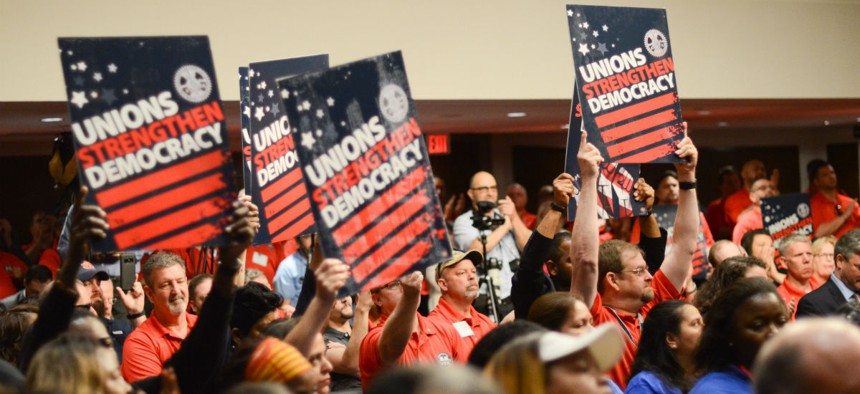OPM Reports 4 Percent Increase in Use of Official Time Over Two Years
Unions call agency’s report, which measures changes from fiscal 2014 to fiscal 2016, misleading about data and official time policies.
The Office of Personnel Management released a report Thursday on the use of official time at federal agencies in fiscal 2016, stating that the amount of paid time used by union officials for representational duties had increased by 4.12 percent since fiscal 2014.
In a press release accompanying the report, OPM officials assailed the practice, in which federal employees are compensated for their work on behalf of the union for representational matters, calling it “taxpayer funded union time” that does not serve the public interest.
“In other words, official time is treated as work time, thus is funded by the American taxpayers while no service to the taxpayer is performed,” OPM wrote.
The report found that in fiscal 2016, union employees used 3,611,112 hours of official time, an increase from 3,468,170 hours in fiscal 2014. That corresponds with an increase of more than 20,000 bargaining unit employees over 2014, or 1.7 percent. Additionally, the number of official time hours used per bargaining unit employee across the federal government increased from 2.88 hours in fiscal 2014 to 2.95 hours in fiscal 2016, an increase of about four minutes.
“The data shows that taxpayer funded union time is at a steady increase,” OPM Director Jeff Pon said in a statement. “This administration is passionate about protecting hardworking Americans and the use of their tax dollars. OPM will continue exploring opportunities to identify useful practices for monitoring and reporting on the use of official time and sharing these practices with agencies across the government to assist agencies in strengthening internal controls and increasing transparency, accountability and accuracy.”
The press release highlights an unnamed union official on 100 percent official time at the Veterans Affairs Department as an example of “problems regarding the use of official time.” If the former registered nurse were to step down from the union position, OPM said VA would be required to continue to employ the RN while the employee spends “months [receiving] retraining and recertification.”
OPM also reported that the cost in pay and benefits for official time increased by $12.3 million, or 7.55 percent, from fiscal 2014 to fiscal 2016.
But federal employee unions argued that OPM’s interpretation of the report purposefully distorts both the official time statistics and how union representatives make use of the practice. Jacque Simon, director of public policy for the American Federation of Government Employees, said the agency is “trying to paint the data in the worst possible light.”
“Think about why the cost went up: you had a 1 percent [across the board] pay increase each of the two years, and then in larger bargaining units with 1,000 or 2,000 people, they will have people who have had step increases, so that’s in that [7.55 percent] number,” Simon said. “And then you have to factor in the cost of health insurance . . . If the cost went up by more than the number of hours, you know, at least some of that is because costs go up generally.”
The report comes just a day after Pon, in a hearing with the House Oversight and Government Reform Committee, again used the phrase “taxpayer funded union time” and said his agency needs to “take a look at” the practice.
“We can’t just write a report and say how much time was used by each and every one of these agencies; we need to actively manage it,” he said. “We need to shed some light on how it’s being used or abused.”
Rep. Elijah Cummings, D-Md., tried to press Pon on his opinion of official time.
“Do you think official time is a major problem?” Cummings asked.
“I think it needs to be examined,” Pon said.
“That’s not what I asked you,” Cummings said. “Do you see it as a major problem?”
“Perhaps in certain agencies,” Pon said.
Simon also noted that OPM’s methodology for estimating the cost of official time assumes that an hour of official time costs the average hourly wage and cost of benefits for a given bargaining unit, despite recommendations from the Government Accountability Office in 2014 recommending the agency do more to narrow down the individual salaries of employees who claim official time.
In its report, OPM rejected those recommendations, noting logistical difficulties in developing stronger reporting metrics.
“Due to limitations in what actual [Enterprise Human Resources Integration] data is available to OPM for all agencies covered in the report and when this data is available to OPM, OPM continues to use the same methodology OPM has traditionally used for this report,” the agency wrote. “To duplicate GAO’s proposed methodology and cross-check OPM’s results for all agencies covered by OPM’s report would require an enormous expenditure of time and resources.”
Tony Reardon, national president of the National Treasury Employees Union, argued OPM’s report actually confirmed that official time is only “used by a tiny fraction of the federal workforce and it is limited to labor-management issues.” Reardon said that counter to the agency’s argument, the practice actually saves the federal government money by defusing labor-management disagreements without the need for lawsuits.
“[Official time] reduces the costs for agencies by having a workable mechanism in place to resolve disputes in a non-adversarial way, as compared to significantly more time-consuming and costly litigation,” he said.




